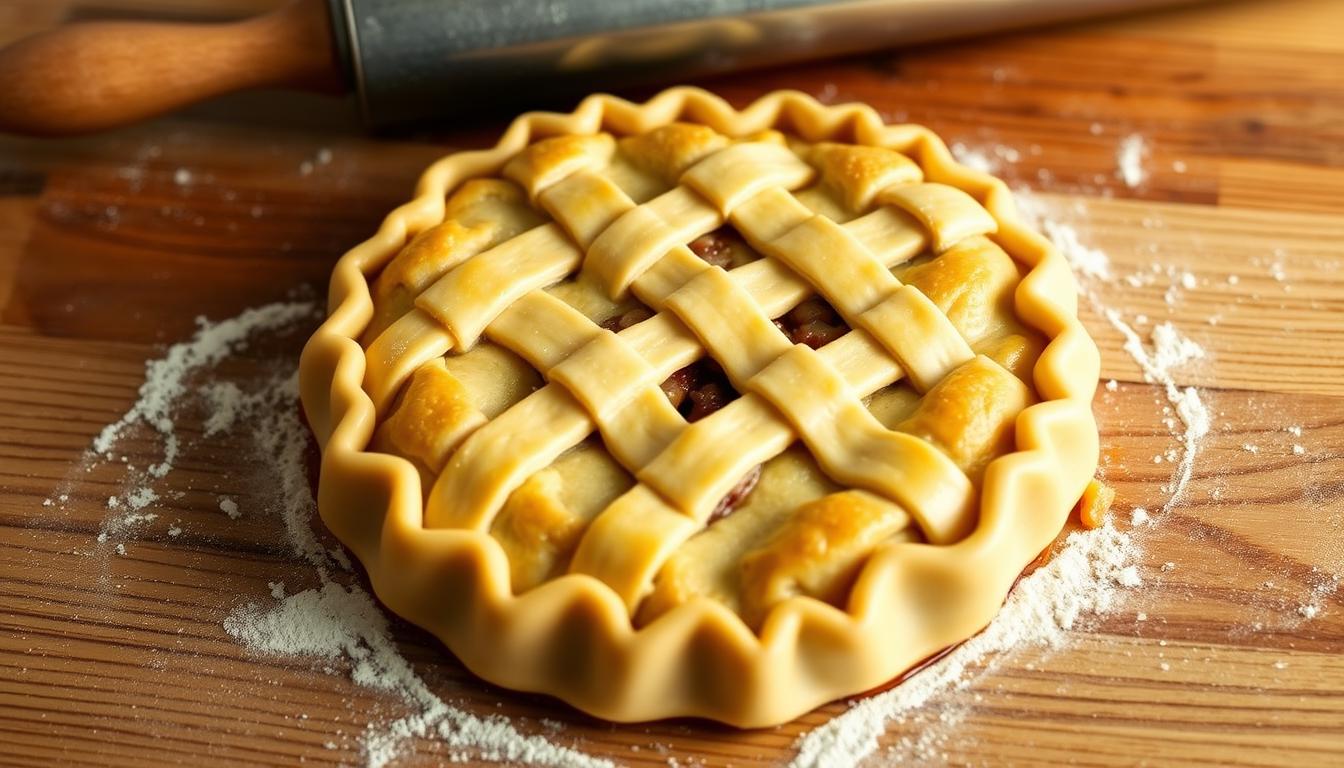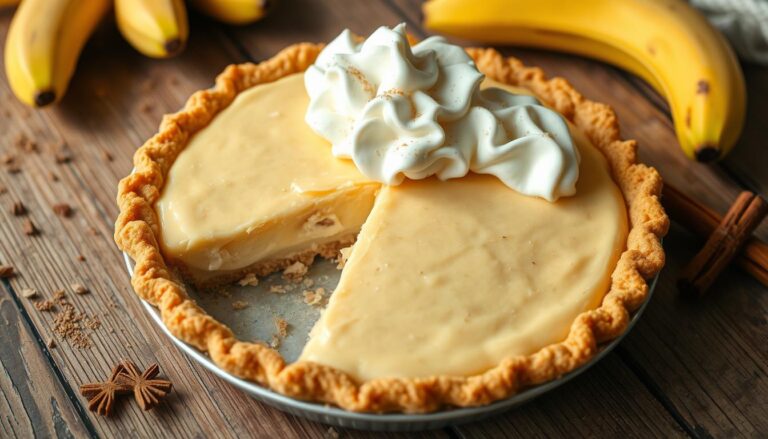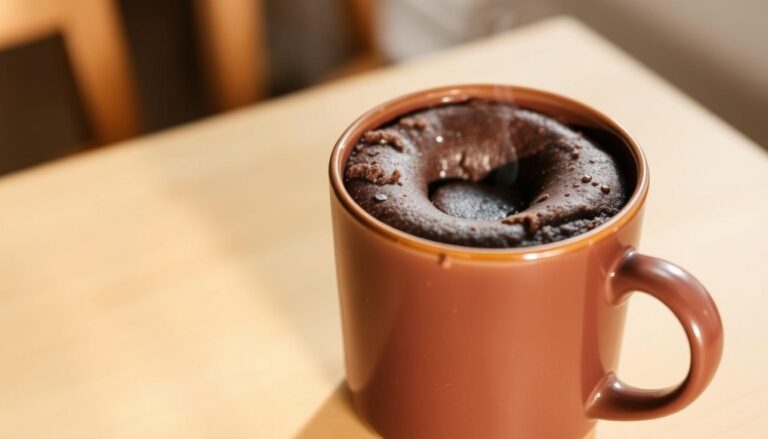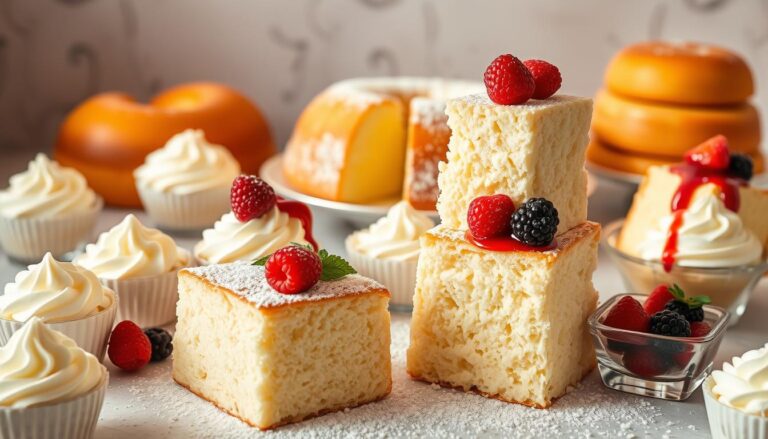There’s something special about a pot pie crust. It shatters into flaky layers, holding warm filling like a golden blanket. For many, that first bite is a promise of comfort, like coming home. But what if you could make that perfect balance of crispness and tenderness every time?
Imagine cold butter cubes, sifted flour, and ice water coming together. This dough turns into a cloud-like crust. The secret is in science and patience. Start with 2 ½ cups of flour, a pinch of salt, and cold butter.
Experts like Cooks Illustrated and Kenji López-Alt say cold fats are key. They create layers that rise, not melt, in the oven.
This pie crust is more than a recipe—it’s a foundation. You can blend it in a food processor or mix by hand. The goal is the same: tender layers that hold their shape. Freeze it for later or let it rest in the fridge. The result? A crust that shines as much as the filling.
There’s something special about a pot pie crust. It shatters into flaky layers, holding warm filling like a golden blanket. For many, that first bite is a promise of comfort, like coming home. But what if you could make that perfect balance of crispness and tenderness every time?
Imagine cold butter cubes, sifted flour, and ice water coming together. This dough turns into a cloud-like crust. The secret is in science and patience. Start with 2 ½ cups of flour, a pinch of salt, and cold butter.
Experts like Cooks Illustrated and Kenji López-Alt say cold fats are key. They create layers that rise, not melt, in the oven.
This pie crust is more than a recipe—it’s a foundation. You can blend it in a food processor or mix by hand. The goal is the same: tender layers that hold their shape. Freeze it for later or let it rest in the fridge. The result? A crust that shines as much as the filling.
Table of Contents
Understanding the Basics of Pot Pie Crust
Learning to make a great pot pie crust starts with knowing its key parts. The best crust comes from cold fats, just the right amount of moisture, and careful handling. Cold butter or shortening makes the crust flaky.
But, overworking the dough or uneven baking can mess up the texture. So, it’s important to be patient.
What Makes a Great Pie Crust
- Cold ingredients: Keep butter, shortening, and water cold to stop gluten from getting too strong.
- Balance: Mix just until combined to avoid a dense crust.
- Resting time: Chilling the dough helps fats stay cold and gluten relax, making it tender.
Traditional vs. Modern Techniques
| Aspect | Traditional Method | Modern Method |
|---|---|---|
| Tool Use | Pastry cutter or fork for mixing | Food processor for quick cutting |
| Fat Incorporation | Cut butter into flour by hand | Pulse processor until pea-sized crumbs form |
| Moisture Control | Gradual water addition by hand | Cold ice water measured precisely |
| Resting | Wrap in cloth, refrigerate 1 hour+ | Use plastic wrap, 15-minute minimum |
Both old and new methods need you to test the dough. It should hold its shape without breaking. Whether rolling it out or using a mixer, aim for a crust that keeps the filling in and crisps up in the oven.
Experts like America’s Test Kitchen suggest a 60:40 dough ratio for the bottom and top. This helps prevent the crust from getting soggy.
Essential Ingredients for a Successful Pot Pie Crust
To make a perfect easy pot pie crust, you need the right ingredients. Start with 2 1/2 cups of all-purpose flour. This is the foundation of both structure and tenderness.
Cold unsalted butter (1 cup, cut into 1/2-inch cubes) is key for flaky layers. Add 1/2 teaspoon of salt to enhance flavor. And don’t forget 1 tablespoon of sugar to balance out the savory fillings. Finally, use 8 tablespoons of ice water to hydrate the dough without overworking it.
- Flour: Measured using the spoon-and-level method to avoid packing.
- Cold Butter: Cubed and chilled to form steam pockets during baking.
- Ice Water: Adds moisture without raising dough temperature.
- Salt: Brings out natural flavors without overpowering.
The secret to a great crust is in how you mix the fat. Cold butter chunks melt into steam, creating flaky layers. But be careful not to overmix, as this can make the dough tough. Adding a bit of sugar can also help with browning and depth.
For best results, use a kitchen scale to measure ingredients accurately. This ensures you get 1 pound of dough for two crusts. If you’re short on time, store-bought options are fine. But making your own crust lets you control the texture and taste.
Always chill your ingredients before mixing. This keeps them cold, which is essential for a crisp, golden easy pot pie crust every time.
Mastering Mixing Techniques for Your Dough
Making perfect homemade pot pie dough starts with mixing. Use cold fats and gentle techniques to create flaky layers. Keep ingredients cold until you’re ready to mix.
The Role of Cold Butter and Fat
Cold butter makes the dough flaky. Here’s how to use it:
- Keep butter and shortening cold until mixing.
- Cut butter into ½-inch cubes, then toss with flour to coat.
- Flatten cubes with fingertips to mix into flour without melting.
Steps for Consistent Mixing
For a uniform texture, follow these steps:
- Pulse butter and shortening in a food processor 2-3 times per batch to leave pea-sized bits.
- Add ice water 3 tablespoons at a time, pulsing once after each addition.
- Finish mixing by hand, kneading only until dough holds together (10-15 seconds).
Balancing Wet and Dry Ingredients
| Ingredient | Guidelines |
|---|---|
| Butter/Flour Ratio | 1:1 weight ratio for structure and flakiness. |
| Water | Add 3 tbsp increments. Stop when dough clumps form. |
| Temperature | Check dough temp: 65-70°F (18-21°C) before chilling. |
Chill the dough for 2-24 hours. This relaxes gluten and keeps fats firm. Avoid overmixing to keep the dough tender.
Tips for Achieving a Light and Flaky Texture
Getting a perfect flaky pot pie crust needs careful attention to temperature and technique. Cold ingredients and precise steps help layers form right. Here are some tips to avoid overworking the dough and keep its delicate structure:
- Chill all ingredients—including flour—before mixing. Use ice water and keep tools cold.
- Use a spray bottle to mist water onto dough. Stop mixing once dough forms a rough ball to preserve texture.
- Rest dough for 45 minutes post-mixing, then chill again for 15 minutes after lining the pan. This halts gluten development.
- Combine butter and shortening (2:1 ratio) for flavor and tenderness. Pulse ingredients in a food processor briefly to avoid overworking.
- Roll dough to 1/8-inch thickness. Rotate the rolling pin 90 degrees between strokes for even spreading.
- Add 1 tbsp white vinegar to the water. Acidity relaxes gluten, enhancing flakiness and moisture retention.
Overmixing or warm fats melt layers too soon, making the crust dense. Let dough rest fully to keep fat intact during baking. These steps make simple ingredients into a golden, layered flaky pot pie crust that shatters crisply when cooled.
| Technique | Result |
|---|---|
| Cold butter layers | Creates steam pockets for flakiness |
| Short chilling periods | Maintains fat integrity |
| Ice water | Slows gluten formation during mixing |
Step-by-Step Guide to Perfecting the Pie Crust for Pot Pie
Every bite of the best pot pie crust recipe starts with precise steps. Follow this guide to transform simple ingredients into a golden, flaky masterpiece.
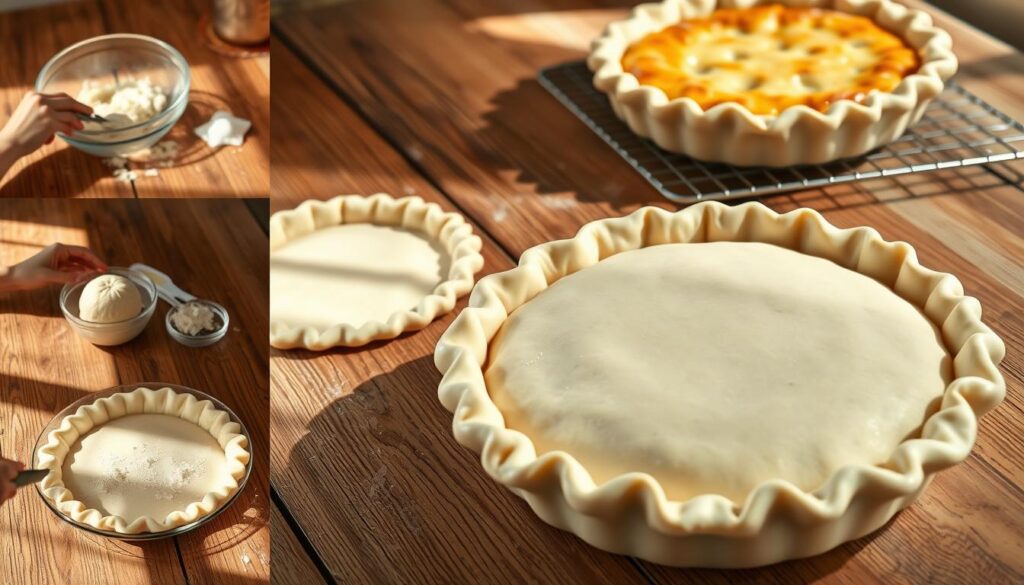
Preparing Your Workstation
Cold ingredients are key. Chill all tools—rolling pin, bowl, and even your hands—for 10 minutes before starting. Use a silicone mat or parchment paper to prevent sticking. Gather equipment: a food processor or pastry cutter, two mixing bowls, and a 9-inch pie dish.
Mixing and Folding Techniques
- In a large bowl, combine 2½ cups flour, 1 tsp salt, and 6 tbsp cold butter (cut into ¼-inch slices).
- Add ¼ cup shortening and mix with a pastry blender until the mixture resembles coarse sand. Pause to add 2 tbsp ice-cold vodka (or water) to boost flakiness.
- Fold in 5–7 tbsp ice water, 1 tbsp at a time, until the dough holds together when pinched. Overmixing leads to toughness—stop once combined.
- Divide dough into two discs, wrap in plastic, and refrigerate for 30+ minutes. Chilling ensures layers form during baking.
Baking and Finishing Touches
Roll dough to ¼-inch thickness on a floured mat. Trim edges, then prick the bottom with a fork to prevent bubbles. Fill the pie, cover with top crust, and seal edges by crimping with a fork. Brush with an egg wash (1 egg + 1 tbsp water) for shine. Bake at 450°F for 15–20 minutes until golden. Cool 10 minutes before serving.
Creative Variations for Your Savory Pie Crust
Make your pot pie crust stand out with bold flavors and textures. Adding herbs or making it diet-friendly can change the classic how to make pot pie crust. Try lattice patterns, braids, or star cutouts to make meals look as good as they taste.
Incorporating Herbs and Spices
Enhance your crust with dried thyme, rosemary, or a bit of black pepper. A pinch of sugar balances out savory fillings. Garlic powder or smoked paprika add smoky notes. For inspiration,
“A mix of fresh parsley and lemon zest brightens the dough,” says pastry chef Clara Bennett.
Substituting Ingredients for Dietary Needs
Swap wheat flour with gluten-free blends like Bob’s Red Mill 1:1 or almond flour. For dairy-free options, use coconut oil or vegan butter. Schmaltz (rendered chicken fat) adds rich flavor without butter. Frozen crusts save time but still let you customize with herbs.
Try these ideas to create a crust that suits your taste. Mix herbs, experiment with textures, and adjust ingredients for your diet. All while mastering how to make pot pie crust in your own way.
Mixing Classic and Modern Techniques in Pie-Making
Combining old and new can make your pot pie crust amazing. First, chill butter cubes in the freezer for 15 minutes. This step is key for flakiness.
Next, blend flour, salt, and baking powder in a food processor. Then, add cold butter and pulse until it’s pea-sized. This quick method keeps your crust flaky without taking too long.
- Traditional method: Hand-cutting butter into flour with a pastry blender creates layers manually.
- Modern upgrade: A stand mixer’s paddle attachment combines dough quickly, preventing overworking.
- Hybrid approach: Chill dough after mixing, then roll it out by hand for optimal tenderness.
Alice Waters, a famous baker, suggests mixing cold butter with flour in a food processor. Then, finish by hand. This mix keeps the dough light and flaky.
For a quick fix, use store-bought dough. Brush it with an egg wash (1 egg + 1 tbsp water) before baking at 375°F for 25–30 minutes.
“A 30-minute rest after rolling prevents shrinkage.” – Pie Science author
Use modern tools like bench scrapers with old-school folding to layer fats. Whether you’re using a food processor or a rolling pin, always chill the dough before baking. This mix of methods gives you a crust that’s both buttery and strong enough for fillings.
Secrets Behind a Perfect Pot Pie Pastry Dough
Every master chef knows that the savory pie crust recipe hinges on precision and patience. Here’s how to unlock the dough’s full potential:
Tips for Consistency and Flavor
- Use 3 to 4 tablespoons of ice water—no more—to prevent sogginess.
- Combine 3 cups flour, 1 tsp salt, 3/4 cup cold shortening, and 1/2 cup cold butter. Mix until crumbly before adding liquid.
- Chill dough for 30 minutes post-mixing to firm up fat layers.
Expert Advice on Flakiness
Pro bakers agree: flakiness starts with fat. Here’s how to apply it:
- Cut butter and shortening into pea-sized pieces for even distribution.
- Roll dough between two parchment sheets to avoid overhandling.
- Let rolled dough rest 15 minutes at room temperature before baking.
| Pro Tip | How It Works |
|---|---|
| Cold butter | Melts slowly during baking, creating steam layers. |
| Ice water | Activates gluten without warming the dough. |
| Freezing | Rests dough 1 hour in freezer for extra-crispy results. |
For long-term storage, wrap dough in plastic and refrigerate up to 2 days or freeze up to 3 months. Thaw frozen dough in the fridge before rolling. Master these secrets, and your savory pie crust recipe will rival professional kitchens every time.
Troubleshooting Common Pie Crust Challenges
Even the best bakers face setbacks. Here’s how to fix pot pie crust challenges and save your next batch:
- Soggy Bottoms: Blind bake the crust first. Line with parchment, add pie weights, and bake at 400°F for 15 minutes before adding filling.
- Overly Tough Crust: Stop mixing when dough looks like coarse crumbs. Overworking turns dough rubbery—cold butter and minimal handling keep it tender.
- Shrinking Dough: Roll gently on a floured surface. Stretching the dough causes shrinkage; let it settle naturally in the pan.
- Cracked Edges: Trim excess dough after chilling. Overhang by 1/2 inch max and fold under the pan edges before baking.
“Cold fats are your ally—never let butter or shortening soften before mixing.” – Alice Medrich, baking expert
Quick fixes:
- Too dry? Sprinkle with ice water, 1 tsp at a time, to bring dough together.
- Overly sticky? Chill dough for 30 minutes to firm up fats.
- Uneven browning? Rotate the pie halfway through baking.
Always keep ingredients chilled: refrigerate flour, butter, and water before mixing. Overmixing or warm dough leads to pie dough problems. Let dough rest at least 1 hour to hydrate flour and relax gluten. For extra insurance, prechill pans before rolling dough into place.
How to Store and Reuse Homemade Pot Pie Dough
Make your homemade dough last longer with smart storage and creative ideas. Follow these steps to keep your dough fresh for new recipes.
Proper Storage Techniques
Keep dough fresh by freezing or refrigerating properly:
- Wrap tightly in plastic wrap and refrigerate for up to 3 days.
- Freeze in labeled airtight bags for up to 3 months. Press into a flat shape for easier thawing.
Reviving Dough for Future Use
To revive frozen dough:
- Thaw in the fridge overnight or at room temp for 2-3 hours.
- Knead briefly to restore flexibility before rolling.
“Proper storage keeps dough ready for any recipe.” – Baking experts recommend gentle handling after thawing.
Turn scraps into tasty snacks like:
- Cinnamon sugar cookies: Roll scraps, slice, and bake at 400°F for 10-12 mins.
- Cheesy crackers: Brush dough with egg wash, sprinkle with Parmesan and rosemary, and bake until crisp.
- Pizza roll-ups: Fill with sauce, cheese, and toppings, roll, and bake for a quick appetizer.
With proper storage and creativity, no dough goes to waste. Try new things with leftover scraps to make new dishes.
Enhancing Flavor with Seasonings and Herbs
Make your pot pie crust more flavorful by trying out different herbs and spices. Whether you want a classic taste or something new, the right seasonings can make every bite special.
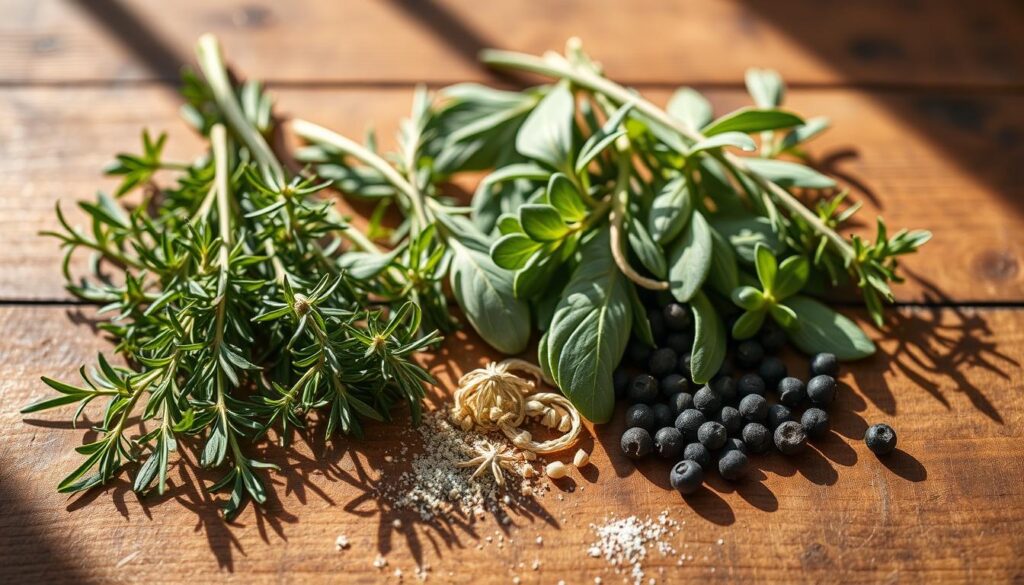
Choose the right crust for your filling:
- Use thyme or rosemary for meat or veggie fillings.
- For pies that are a bit sweet and savory, add cinnamon or cardamom.
- Garlic powder or onion powder can add a deep savory taste.
Try global flavors for a unique crust:
- Garam masala or cumin gives a Middle Eastern touch.
- Za’atar or sumac is great for Mediterranean pies.
- Herbs de Provence adds a French country feel.
Be bold with these ideas:
- Grated cheese in the dough adds a savory richness.
- A pinch of nutmeg or ginger brings winter warmth.
- For a citrusy twist, add lemon or orange zest.
Don’t be afraid to experiment. Small changes in seasoning can make a big difference in taste.
Conclusion
Chicken pot pie’s charm begins with the pot pie crust. Cold butter and careful mixing create a flaky, golden crust. You can make it at home or buy it, but the key is in the thickening and baking.
Adding herbs or making dietary changes can make it even better. A final egg wash gives it a shiny finish. Using disposable pans makes cleaning up a breeze.
Baking Coach’s guides offer pot pie recipes with flavors from around the world. This dish is special because it combines tradition with new ideas. With these tips, you can make a crust that’s both comforting and unique, great for any meal.

